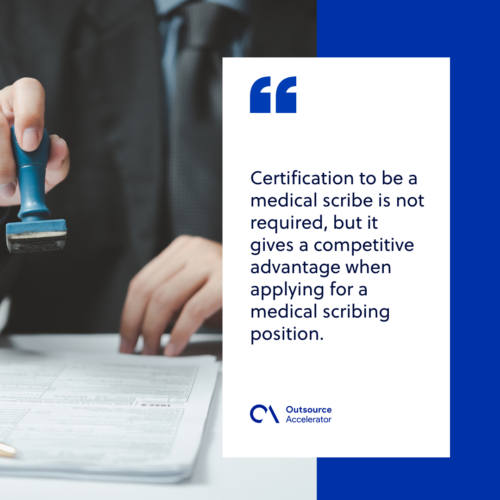Medical scribing: Enhancing efficiency and patient care

Medical scribing is often considered a foundational process that aids medical professionals in providing the best patient experience.
Medical scribes are vital because documentation is crucial in the healthcare industry. Medical scribing may sound simple, but it actually requires a lot of skill and dedication.
Read on to understand the medical scribing process and why it can enhance overall efficiency and patient care.
Understanding medical scribing
Medical scribing is the process where a trained professional, called a medical scribe, documents a patient’s encounters in real time. This process allows healthcare providers to focus solely on patient care.
A medical scribe works with healthcare providers by supplying primary clerical and non-clinical support.
Medical scribes record patient encounters by shadowing healthcare providers or noting from a patient’s electronic medical record (EMR) or electronic health record (EHR). They can either be certified medical assistants, medical students, or healthcare professionals specializing in documentation.

Responsibilities of medical scribes
A medical scribe’s main job is to record encounters between healthcare providers and patients. The most significant things they document are a patient’s:
- Medical history
- Diagnoses
- Examination findings
- Treatment plans
- Medications prescribed
Additionally, medical scribing covers administrative tasks such as scheduling appointments and managing patient records.
Qualifications and training required for medical scribes
There are several requirements for someone to be qualified for a medical scribing position:
Education
A medical scribing role’s minimum educational requirement is a high school diploma or equivalent. Many employers prefer those who have taken a college course/degree or certification that’s related to the field.
Sourcing from a professional firm like Connext will ensure that you receive a fully-capable offshore worker.
Training
Medical scribes can take online or on-site programs. The programs supply fundamental medical knowledge and terminology so candidates are able to enact medical scribing successfully.
Certification
Certification to be a medical scribe is not required, but it gives a competitive advantage when applying for a medical scribing position. Examples of certifications one can acquire include:
- Certified Medical Scribe Associate (CMSA)
- Certified Medical Scribe Specialist (CMSS)
- Medical Scribe Certification and Aptitude Test (MSCAT)
- Certified Medical Scribe Professional (CMSP)
- Apprentice Medical Scribe Professional (AMSP)
- Healthcare Documentation Integrity Specialist (HDIS)
- Health Information Technology Professional (HITP)
- Electronic Health Records Professional (EHRP)

Skills
Medical scribing calls for a number of essential skills needed to be successful in that role:
- Computer skills
- Organizational skills
- Attention to detail
- Exceptional bedside manner
- Medical knowledge
- Superb interpersonal skills
- Physical stamina
3 types of medical scribes
There are a few types of medical scribes, including:
Traditional medical scribes
Traditional medical scribes are those who work on-site, in-house, or in-person with healthcare providers.
Virtual medical scribes
Virtual medical scribes do the medical scribing process remotely, usually dealing with EMR and EHR systems.
Emergency department medical scribes
Emergency department medical scribes are those who are assigned to and specialize in fast-paced emergency settings.
The medical scribing process
The medical scribing process typically involves the following steps:
Introduction
A medical scribe accompanies the healthcare provider to meet the patient. The healthcare provider then introduces the medical scribe to the patient and explains their role in the encounter.
Documentation
The medical scribe begins recording the encounter using shorthand and EMR software. They document anything of significance that the healthcare provider dictates to the patient.
The medical scribe may also assist with administrative tasks such as scheduling follow-up appointments.
Review
After the encounter, the healthcare provider reviews and approves the medical scribe’s documentation.
Coding and billing can also be a part of the medical scribing process, ensuring that the encounter is properly documented for reimbursement purposes.

How medical scribing boosts efficiency and patient care
Providing high-quality care is vital in the medical industry and medical scribing boosts those chances.
Here are some of the reasons why medical scribing benefits the healthcare experience for both providers and patients:
Increases patient flow
Outsourcing the task of medical scribing is a game-changer if medical practices want to keep up with patient demand as it handles administrative tasks that are usually time-consuming.
When efficiency is seen upon the designation of a medical scribe, healthcare providers can direct their focus and attention to providing the best patient care.
Improves revenue and patient access
When the patient flow increases, a medical practice can generate more revenue because medical scribing allows it to see more patients.
Further, patients would then have better access to care due to reduced wait times and appointment backlogs.
Better documentation
Medical scribing refines the documentation process, which results in better patient care. Medical scribes can concentrate on making the documentation complete and accurate while lessening the burden on practitioners.
They divide their attention between recording patient records instead of patient care.
Enhanced patient satisfaction
Medical scribing decreases the distraction to healthcare providers caused by administrative tasks. In return, patients feel like they are more focused on and cared for during their appointments.
Medical scribing promotes excellent patient experience
Overall, medical scribing aims to provide the best patient experience by granting healthcare providers more time and effort to direct their attention and care to patients.
This makes it a necessary part of the healthcare process, and anyone in the medical sector should consider adopting it to improve healthcare services.







 Independent
Independent




